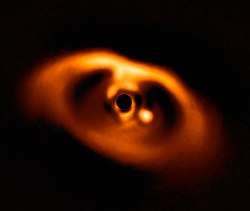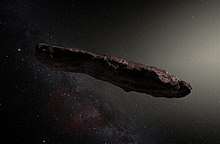TRAPPIST-1h
TRAPPIST-1h, also designated as 2MASS J23062928-0502285 h, is an exoplanet orbiting around the ultra-cool dwarf star TRAPPIST-1 39 light-years (12 parsecs) away from Earth in the constellation Aquarius. It was one of four new exoplanets to be discovered orbiting the star using observations from the Spitzer Space Telescope.[4][5] Throughout 2017 and 2018, more studies were able to refine its physical parameters.
 Artist's impression of TRAPPIST-1h. | |
| Discovery | |
|---|---|
| Discovery date | 2017 |
| Transit | |
| Orbital characteristics | |
| Apastron | 0.06229 +0.0000031 −0.000004 AU |
| Periastron | 0.06158 +0.0000034 −0.000004 AU |
| 0.06193488 ± 8.0e-07[1] AU | |
| Eccentricity | 0.00567 (±0.00121)[1] |
| 18.868+0.008 −0.009[1] d | |
| Inclination | 89.796 (± 0.023)[2] |
| Star | TRAPPIST-1[3] |
| Physical characteristics | |
Mean radius | 0.773 +0.026 −0.027[1] R⊕ |
| Mass | 0.331 +0.056 −0.049[1] M⊕ |
Mean density | 3.97 +0.645 −0.563 g/cm3 g cm−3 |
| 0.555 +0.088 −0.076[1] g | |
| Temperature | 169.2 ± 2.4 K (−103.95 ± 2.40 °C; −155.11 ± 4.32 °F)(equilibrium)[2] |
The outermost known planet in its system, it is roughly one third the mass of Earth, and about 77% as large. Its relatively low density indicates that it is likely water-rich, like several other planets in the system.
Characteristics
Mass, radius, and temperature
TRAPPIST-1h has a radius of 0.773 R⊕, a mass of 0.331 M⊕, and about 56% Earth's surface gravity. It has a density of 3.97 g/cm3, extremely similar to that of Mars. Given this density, about ≤5% of its mass must be water, likely in the form of a thick ice shell, seeing as it only receives about 13% of the stellar flux that Earth does. It has an equilibrium temperature of 169 K (−104 °C; −155 °F), similar to that of Earth's south pole.
Host star
TRAPPIST-1h orbits the ultracool dwarf star TRAPPIST-1. It is 0.121 R☉ and 0.089 M☉, with a temperature of 2511 K and an age between 3 and 8 billion years. For comparison, the Sun has a temperature of 5778 K and is about 4.5 billion years old. TRAPPIST-1 is also very dim, with about 0.0005 times the luminosity of the Sun. The star's apparent magnitude, or how bright it appears from Earth's perspective, is 18.8. Therefore, it is too dim to be seen with the naked eye.
Orbit
Despite it being the most distant known planet in its system, TRAPPIST-1h orbits its host star with an orbital period of 18.868 days and an orbital radius of about 0.0619 AU. This is even smaller than Mercury's orbit around the Sun (which is about 0.38 AU).[6]
Might host water
Although TRAPPIST-1h's orbit falls within its star's frost line it could harbor liquid water[7][8] under an H2-rich atmosphere, either primordial or resulting from continuous outgassing combined with internal heating.[6] It could also potentially harbor a subsurface ocean by way of tidal heating, which can lead to volcanic activity and the formation of geysers.
See also
References
- Grimm, Simon L.; Demory, Brice-Olivier; Gillon, Michael; Dorn, Caroline; Agol, Eric; Burdanov, Artem; Delrez, Laetitia; Sestovic, Marko; Triaud, Amaury H.M.J.; Turbet, Martin; Bolmont, Emeline; Caldas, Anthony; de Wit, Julien; Jehin, Emmanuel; Leconte, Jeremy; Raymond, Sean N.; Van Grootel, Valerie; Burgasser, Adam J.; Carey, Sean; Fabrycky, Daniel; Heng, Kevin; Hernandez, David M.; Ingalls, James G.; Lederer, Susan; Selsis, Franck; Queloz, Didier (2018). "The nature of the TRAPPIST-1 exoplanets". Astronomy & Astrophysics. 613: A68. arXiv:1802.01377. Bibcode:2018A&A...613A..68G. doi:10.1051/0004-6361/201732233.
- Delrez, Laetitia; Gillon, Michael; H.M.J, Amaury; Brice-Oliver Demory, Triaud; de Wit, Julien; Ingalls, James; Agol, Eric; Bolmont, Emeline; Burdanov, Artem; Burgasser, Adam J.; Carey, Sean J.; Jehin, Emmanuel; Leconte, Jeremy; Lederer, Susan; Queloz, Didier; Selsis, Franck; Grootel, Valerie Van (2018). "Early 2017 observations of TRAPPIST-1 with Spitzer". Monthly Notices of the Royal Astronomical Society. 475 (3): 3577–3597. arXiv:1801.02554. Bibcode:2018MNRAS.475.3577D. doi:10.1093/mnras/sty051.
- Van Grootel, Valerie; Fernandes, Catarina S.; Gillon, Michaël; Jehin, Emmanuel; Scuflaire, Richard; et al. (2018). "Stellar parameters for TRAPPIST-1". The Astrophysical Journal. 853: 30. arXiv:1712.01911. Bibcode:2018ApJ...853...30V. doi:10.3847/1538-4357/aaa023.
- "Temperate Earth-Sized Planets Found in Extraordinarily Rich Planetary System TRAPPIST-1". SpaceRef. 22 February 2017. Retrieved 11 February 2017.
- "NASA telescope reveals largest batch of Earth-size, habitable-zone planets around single star". Exoplanet Exploration: Planets Beyond our Solar System (Press release). Retrieved 22 February 2017.
- Luger, Rodrigo; Sestovic, Marko; Kruse, Ethan; Grimm, Simon L.; Demory, Brice-Olivier; et al. (2017). "A terrestrial-sized exoplanet at the snow line of TRAPPIST-1". Nature Astronomy. 1: 0129. arXiv:1703.04166. Bibcode:2017NatAs...1E.129L. doi:10.1038/s41550-017-0129.
- Bourrier, Vincent; de Wit, Julien; Jäger, Mathias (31 August 2017). "Hubble delivers first hints of possible water content of TRAPPIST-1 planets". www.SpaceTelescope.org. Retrieved 4 September 2017.
- PTI (4 September 2017). "First evidence of water found on TRAPPIST-1 planets - The results suggest that the outer planets of the system might still harbour substantial amounts of water. This includes the three planets within the habitable zone of the star, lending further weight to the possibility that they may indeed be habitable". The Indian Express. Retrieved 4 September 2017.



